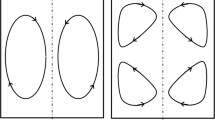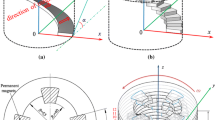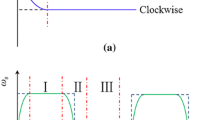Abstract
A flow of liquid GaInSn, which has been investigated experimentally in a companion article,[1] is modeled analytically in this article. The role of this electromagnetically driven flow is to transport the solute rejected by the solidifying interface at significant distances in the melt, and to periodically reverse its circulation such that macrosegregation is minimized. First, we present an analytical derivation of the electromagnetic force, exhibiting its space and time variations, which are essentially legitimate in the central part of the fluid domain. A model for the recirculating fluid flow is also derived, assuming that in this central region the flow is quasiparallel to the main axis. The narrowness of the fluid domain must be taken into account, to achieve a satisfactory agreement with the measurements.





Similar content being viewed by others
Abbreviations
- A :
-
vector potential (T·m)
- A 0 :
-
amplitude of the vector potential (∼10−3 T·m)
- a :
-
half-width of liquid domain in y direction (5 mm)
- a n , b n :
-
coefficient of Fourier series
- B :
-
magnetic field (T)
- B x , B y , B z :
-
components of magnetic field (T)
- B 0 :
-
amplitude of the magnetic field (∼102 T)
- C :
-
coefficient of transversal end effect
- F 0 :
-
electromagnetic forces (∼102 N/m3)
- F :
-
electromagnetic force (N/m3)
- F x , F y , F z :
-
components of the electromagnetic forces (N/m3)
- f 0 :
-
basic frequency (50(60) Hz)
- f m :
-
inverse modulation frequency (∼0 to 6 Hz)
- H :
-
liquid domain height (6 cm)
- J :
-
electric current
- j x , j y , j z :
-
components of the electric current (A/m3)
- k :
-
\( k = \frac{{2\pi }} {l} \), wave number (98 m−1)
- k * :
-
\( k^{{*2}} = k^{2} + \frac{{\pi ^{2} }} {{4a^{2} }} \), wave number in narrow liquid domain (329 m−1)
- L :
-
liquid domain length (10 cm)
- l :
-
wavelength (64 mm)
- l m :
-
\( l_{m} = l\frac{{f_{0} }} {{f_{m} }} \) (mm)
- M(z), G(y), Q(z):
-
coordinate-dependent function of vector potential
- m(t):
-
time-dependence modulation function
- P :
-
pressure (N/m2)
- T :
-
time (s)
- t 0 :
-
fraction of half-period during which TMF travels in one direction (s)
- t i :
-
interval time of half-period during which TMF travels in one direction (80 ms)
- U 0 :
-
core flow velocity in the vertical symmetry plane (m/s)
- u 0 :
-
core flow velocity (m/s)
- U s :
-
synchronism velocity of linear inductor (m/s)
- X :
-
X = kx + βz−ω0 t
- X * :
-
\( X^{*} = k^{*} x + \frac{{\pi y}} {{2a}} + \beta ^{*} z - \omega _{0} t \)
- \( \ifmmode\expandafter\tilde\else\expandafter\sim \fi{X}^{*} \) :
-
\( \ifmmode\expandafter\tilde\else\expandafter\sim \fi{X} = k^{*} m{\left( t \right)}x + \frac{{\pi y}} {{2a}} + \beta ^{*} z - \omega _{0} t \)
- α :
-
α = k (98 m−1)
- α * :
-
α* ≈ k* (329 m−1)
- β :
-
\( \beta = - \frac{{\mu \sigma \omega _{0} }} {{2k}} \) (−6.8 m−1)
- β * :
-
\( \beta ^{*} = - \frac{{\mu \sigma \omega _{0} }} {{2k^{*} }} \) (−2.0 m−1)
- δ m :
-
skin depth of magnetic field, δ m = 1/α (10.2 mm)
- δ l :
-
laminar flow boundary layer, \( \delta _{l} = {\sqrt {\frac{{\nu {\cdot} x}} {{U_{0} }}} } \)
- δ t :
-
turbulence flow boundary layer, \( \delta _{t} = {\sqrt {\frac{{a {\cdot} x}} {{10}}} } \)
- δ ω :
-
oscillating flow boundary layer, \( \delta _{\omega } = {\sqrt {\nu \mathord{\left/ {\vphantom {\nu {2\pi f_{m} }}} \right. \kern-\nulldelimiterspace} {2\pi f_{m} }} } \)
- μ :
-
magnetic permeability (4π × 10−7 H m−1)
- ν :
-
kinematic viscosity (3.4 × 10−7 m2 s−1)
- ν t :
-
turbulence viscosity (1.25 × 10−5 m2 s−1)
- ρ :
-
GaInSn (6.4 × 103 kg m−3)
- σ :
-
electrical conductivity (3.4 × 106 (Ω·m)−1)
- τ = l/2:
-
pole pitch (32 mm)
- φ:
-
scalar potential
- ω 0 :
-
basic angle frequency ω0 = 2π·f 0 (100 π)
- ω m :
-
modulation angle frequency ω m = 2π·f m
References
X.D. Wang, Y. Fautrelle, J. Etay, and R. Moreau: Metall. Mater. Trans. B, 2009. DOI:10.1007/s11663-008-9176-0
X.D. Wang, A. Ciobanas, and Y. Fautrelle: Mater. Sci. Forum, 2006, vol. 508, pp. 163–68
S. Eckert, P.A. Nikrityuk, D. Raebiger, K. Eckert, and G. Gerbeth: Metall. Mater. Trans. B, 2007, vol. 38B, pp. 977–88
B. Willers, S. Eckert, P.A. Nikrityuk, D. Raebiger, J. Dong, K. Eckert, and G. Gerbeth: Metall. Mater. Trans. B, 2008, vol. 39B, pp. 304–16
R. Moreau: Magnetohydrodynamics, Kluwer Academic Publishers, Dordrecht, Netherlands, 1990, pp. 250−51
T. Robinson, and K. Larsson: J. Fluid Mech., 1973, vol. 60, pp. 641–64
H. Schlichting: Boundary-Layer Theory, 7th ed., J. Kerstin, transl., McGraw-Hill Press, New York, NY, 1990, pp. 26 and 42
Acknowledgments
The authors acknowledge the Europe Space Agency, specifically, the CETSOL project (ESA-MAP AO-99-117) and the European Commission, under PI-IMPRESS (Contract No. NMP3-CT-2004-500635), for their financial support.
Author information
Authors and Affiliations
Corresponding author
Additional information
Manuscript submitted April 11, 2008.
Appendix
Appendix
To solve the second-order differential equation
let us denote r 2=k 2 − iμσω, while r = α ± iβ is a complex number, the real and imaginary parts of which satisfy
The two roots are such that the general solution of Eq. [A1] is
To get a zero value of M(z → ∞), we must chose C 1 = 0; we get
The boundary condition at the bottom wall (j z (z = 0) = 0) is satisfied, because the real part of M(z) cancels as sin (βz).
With the usual definition \( \delta = {\sqrt {\frac{2} {{\mu \sigma \omega }}} } \), ω = 2πf, the solution of [A2] can be written as
In the case f = 50 Hz, \( \frac{4} {{k^{4} \delta ^{4} }} \ll 1 \), so that we can take the approximate values
This means that, under the conditions of this experiment, the skin depth α−1 is not determined by the frequency but by the pole pitch.
The same technique applies to the case of a narrow liquid domain, with the new equation
In order to keep this algebra valid, we simply have to introduce \( k^{{ * 2}} = k^{2} + {\left( {\frac{\pi } {{2a}}} \right)}^{2} \) and
to make this algebra still valid. The approximation \( \frac{4} {{k^{{*4}} \delta ^{4} }} \ll 1 \) is still justified, so that the expressions in Eq. [A6] can be generalized as
Rights and permissions
About this article
Cite this article
Wang, X., Moreau, R., Etay, J. et al. A Periodically Reversed Flow Driven by a Modulated Traveling Magnetic Field: Part II. Theoretical Model. Metall Mater Trans B 40, 104–113 (2009). https://doi.org/10.1007/s11663-008-9210-2
Published:
Issue Date:
DOI: https://doi.org/10.1007/s11663-008-9210-2




